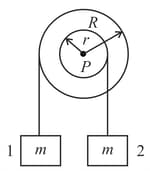A uniform rod of mass m and length can rotate in a vertical plane about a smooth horizontal axis hinged at point .

(a) Find angular acceleration of the rod just after it is released from initial horizontal position from rest?
(b) Calculate the acceleration (tangential and radial) of point at this moment.

(a) Find angular acceleration of the rod just after it is released from initial horizontal position from rest?

Important Questions on Rigid Body Dynamics: Part 1
A uniform rod of mass and length can rotate in a vertical plane about a smooth horizontal axis hinged at point . Find the force exerted by the hinge just after the rod is released from rest, from an initial horizontal position?

A wheel of radius and moment of inertia about its axis is fixed at the top of an inclined plane of inclination as shown in figure. A string is wrapped around the wheel and its free end supports a block of mass which can slide on the plane. Initially, the wheel is rotating at a speed in a direction such that the block slides up the plane. How far will the block move before stopping?
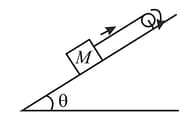
A uniform rod of mass and length is placed on a sharp support such that and . A spring of force constant is attached to end as shown in figure. To keep the rod horizontal, its end is tied with a thread such that the spring is elongated by . Calculate reaction of support when the thread is burnt.
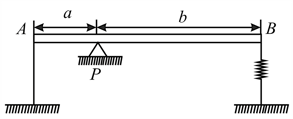
A uniform solid cylinder , of mass , can freely rotate about a horizontal axis fixed to a mount , of mass . A constant horizontal force , is applied to the end , of a light thread tightly wound on the cylinder. The friction between the mount and the supporting horizontal plane is assumed to be absent. Find:
the acceleration of the point
the kinetic energy of this system, after the beginning of motion.
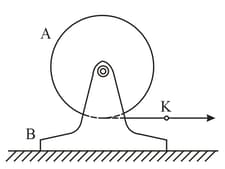
A disc of mass and radius is pivoted smoothly with a block of mass A force acts on and another force acts on . Assume that ground is smooth. Find the:
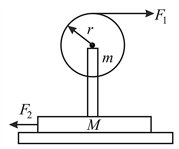
(i) Linear acceleration of the disc.
(ii) angular acceleration of the disc.
A light rigid rod is connected rigidly with two identical particles each of mass m as shown. The free end of the rod is smoothly pivoted at . The rod is released from rest from its horizontal position at . Find:

(i) angular acceleration of the rod, at .
(ii) reaction offered by the pivot, at
Two blocks each of mass m are hanging from a stepped pulley by an inextensible light string which passes over a stepped pulley. The mass of the pulley is and its radius of gyration is . If the string does not slide on the pulley, find the accelerations of the blocks.
